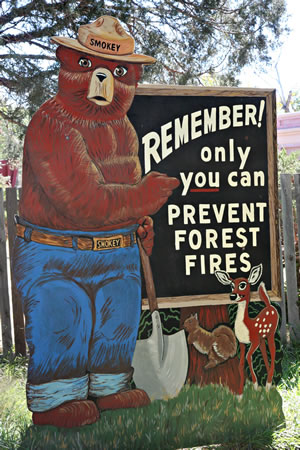Traditionally, we don’t think of springtime as a time to be particularly aware of fires and fire safety, but it is a time when we should be especially aware. As warmer weather approaches, fun involving family, friends and kids, moves to the outdoors with activities like hiking, picnicking and camping picking up steam. The more people camp, the greater likelihood of campfires. And frequently, people who are not necessarily familiar with fires and fire safety travel to wooded areas to share that first breath of spring. Ironically, that breath could be filled with smoke if people are not careful or simply don’t know… campfire safety.
As any Boy Scout will tell you, before you build a fire in a campground or wooded area, consult the area’s Park Ranger, to see if there are particular burning or campfire rules or other information regarding fire associated with that particular Park. It may not be a good time to burn, period! Once you know the rules, you need to look around your proposed campfire site. Note your location–where you and your fire will be in case of any emergency! Are there hanging branches or dry brush within a radius of ten feet from your proposed fire or grill? Sparks or burning particles from your fire can travel on a current of air, so you had better make sure the vicinity of your proposed campfire is clear of any burnable debris, hanging branches, dry brush, and grass (or any other object!) that could burn and cause sparks to fly and that there is no wind! Make sure there are no flammable items in the area of your proposed campfire–and that includes clothing, chair pillows, toys, etc.
Once you have cleared all debris, (including grass and garbage) from a five-foot ring around your proposed campfire, so that cleared soil is exposed in that five-foot ring, you can place rocks around the ring to help contain the campfire, and begin to build your campfire.
When building a fire, you should have water nearby (and if your camper or RV has one, as it should, a fire extinguisher is an added safety device). A shovel and a bucket, for dirt or water, to help douse the fire when you are done toasting or roasting or just keeping warm is also a necessity. Start to lay your fire by building a teepee of small firewood adding larger dry pieces of wood as the fire grows. Do not use “firelighter” or other flammable liquids or kerosene to start your fire as the fire may grow too large and get out of hand very quickly! Who’s watching the fire? Someone needs to keep an eye on the fire at all times. This is not a joke. If this is a sleep-over, make sure to put out your campfire completely before hitting the sack. Douse the fire with water and/or dirt and make sure the coals are stirred and cold before leaving that campfire site.
We are fortunate to have excellent parks in America and areas where people can get out-of-doors to enjoy natural surroundings. We need to protect our woodland areas and parks, so that they can continue to be enjoyed by all. Remember Smokey’s warning, “Only YOU can prevent forest fires!” Please, if you smoke, remember to properly extinguish cigarettes while in a wooded area or park. Ninety (90) percent of wildfires in the United States are caused by humans.

